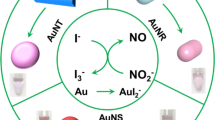Abstract
The authors show that gold nanorods (AuNRs) are viable optical nanoprobes for the determination of cyanide ions. The method is based on the measurement of localized surface plasmon resonance (SPR) absorption which strongly depends on the width-to-height ratio of AuNRs. AuNRs are selectively etched by cyanide at the transverse faces, this leading to a decrease in the AuNR aspect ratio and resulting in a blue-shifted SPR absorption and color change from peacock blue to pink. The mechanism of selective etching of the AuNR tips was studied, and optimum conditions for etching were established. The absorption ratio of transverse to longitudinal SPR absorptions (at 538 and 640 nm, respectively) was proportional to the concentration of cyanide in the range from 1.65 nM to 0.5 mM, with a 0.5 nM detection limit. This colorimetric assay is selective, sensitive, and has been successfully applied to quantify cyanide in spiked tap, pond, and waste water.

Schematic illustration of the gold nanorod (AuNR) etching process induced by CN¯. The AuNR is capped with cetyltrimethylammonium bromide (CTAB) micelles.





Similar content being viewed by others
References
Shifrin NS, Beck BD, Gauthier TD, Chapnick SD, Goodman G (1996) Chemistry, toxicology, and human health risk of cyanide compounds in soils at former manufactured gas plant sites. Regul Toxicol Pharmacol 23:106–116
Eisler R (1991) Cyanide hazards to fish, wildlife, and invertebrates: a synoptic review. Biol Rep 85:1–58
U.S. EPA (1999) Integrated Risk Information System (IRIS) on Cyanide. National Center for Environmental Assessment, Office of Research and Development, Washington, DC., http://cfpub.epa.gov/ncea/iris/iris_documents/documents/subst/0060_summary.pdf. Accessed 16 May 20.
Ren J, Zhu W, Tian H (2008) A highly sensitive and selective chemosensor for cyanide. Talanta 75:760–764
Wu X (2012) Molecular imprinting for anion recognition in aqueous media. Microchim Acta 176:23–47
Gao J, Guo L, Wu J, Feng J, Wang S, Lai F, Xie J, Tian Z (2014) Simple and sensitive detection of cyanide using pinhole shell-isolated nanoparticle-enhanced Raman spectroscopy. J Raman Spectrosc 45:619–626
Noroozifar M, Khorasani-Motlagh M, Taheri A (2011) Determination of cyanide in wastewaters using modified glassy carbon electrode with immobilized silver hexacyanoferrate nanoparticles on multiwall carbon nanotube. J Hazard Mater 185:255–261
Ghanavati M, Azad RR, Mousavi SA (2014) Amperometric inhibition biosensor for the determination of cyanide. Sensors Actuators B Chem 190:858–864
Liu G, Liu J, Hara K, Wang Y, Yu Y, Gao L, Li L (2009) Rapid determination of cyanide in human plasma and urine by gas chromatography–mass spectrometry with two-step derivatization. J Chromatogr B 877:3054–3058
Noroozifar M, Khorasani-Motlagh M, Hosseini SN (2005) Flow injection analysis–flame atomic absorption spectrometry system for indirect determination of cyanide using cadmium carbonate as a new solid-phase reactor. Anal Chim Acta 528:269–273
Cyanide Test Method (2016) colorimetric with test strips and reagents 1, 3, 10, 30 mg/l CN− MQuant™, http://www.merckmillipore.com/DE/en/product/Cyanide-Test,MDA_CHEM-110044.
Dräger Gas Detection.(2016) http://www.draeger.com/sites/assets/PublishingImages/Products/cin_x-zone_5000/ US/gas-detection-br-9041145 -us.pdf.
Randviir EP, Banks CE (2015) The latest developments in quantifying cyanide and hydrogen cyanide. Trends Anal Chem 64:75–85
Dong Y, Wang R, Tian W, Chi Y, Chen G (2014) Turn-on” fluorescent detection of cyanide based on polyamine-functionalized carbon quantum dots. RSC Adv 4:3701–3705
Shamsipur M, Rajabi HR (2014) Pure zinc sulfide quantum dot as highly selective luminescent probe for determination of hazardous cyanide ion. Mater Sci Eng C 36:139–145
Ensafi AA, Kazemifard N, Rezaei B (2015) Label-free and turn-on fluorescent cyanide sensor based on CdTe quantum dots using silver nanoparticles. RSC Adv 5:40088–40093
Kim MH, Kim S, Jang HH, Yi S, Seo SH, Han MS (2010) A gold nanoparticle-based colorimetric sensing ensemble for the colorimetric detection of cyanide ions in aqueous solution. Tetrahedron Lett 51:4712–4716
Hajizadeh S, Farhadi K, Forough M, Sabzi RE (2011) Silver nanoparticles as a cyanide colorimetric sensor in aqueous media. Anal Methods 3:2599–2603
Zeng JB, Cao YY, Chen JJ, Wang XD, JF Y, BB Y, Yan ZF, Chen X (2014) Au@Ag core/shell nanoparticles as a colorimetric probe for cyanide sensing. Nanoscale 6:9939–9943
Zhang G, Qiao Y, Xu T, Zhang C, Zhang Y, Shi L, Shuang S, Dong C (2015) Highly selective and sensitive nanoprobes for cyanide based on gold nanoclusters with red fluorescence emission. Nanoscale 7:12666–12672
Mu J, Feng Q, Chen X, Li J, Wang H, Li MJ (2015) Silica nanoparticles doped with an iridium (III) complex for rapid and fluorometric detection of cyanide. Microchim Acta 182:2561–2566
Cao J, Sun T, Grattan KTV (2014) Gold nanorod-based localized surface plasmon resonance biosensors: a review. Sensors Actuators B Chem 195:332–351
Chen H, Shao L, Lia Q, Wang J (2013) Gold nanorods and their plasmonic properties. Chem Soc Rev 42:2679–2724
Jana NR, Gearheart L, Obare SO, Murphy CJ (2002) Anisotropic chemical reactivity of gold spheroids and nanorods. Langmuir 18:922–927
Rodríguez-Fernández J, Pérez-Juste J, Mulvaney P, Liz-Marzán LM (2005) Spatially-directed oxidation of gold nanoparticles by Au(III)-CTAB complexes. J Phys Chem B 109:14259–14261
Tsung CK, Kou X, Shi Q, Zhang J, Yeung MH, Wang J, Stucky GD (2006) Selective shortening of single-crystalline gold nanorods by mild oxidation. J Am Chem Soc 128:5352–5353
Green TA (2014) Gold etching for microfabrication. Gold Bull 47:205–216
Zou R, Guo X, Yang J, Li D, Peng F, Zhang L, Wang H, Yu H (2009) Selective etching of gold nanorods by ferric chloride at room temperature. CrystEngComm 11:2797–2803
Thatai S, Khurana P, Prasad S, Kumar D (2014) A new way in nanosensors: gold nanorods for sensing of Fe(III) ions in aqueous media. Microchem J 113:77–82
Li FM, Liu JM, Wang XX, Lin LP, Cai WL, Lin X, Zeng YN, Li ZM, Lin SQ (2011) Non-aggregation based label free colorimetric sensor for the detection of Cr (VI) based on selective etching of gold nanorods. Sensors Actuators B Chem 155:817–822
Chen Z, Zhang Z, Qu C, Pan D, Chen L (2012) Highly sensitive label-free colorimetric sensing of nitritebased on etching of gold nanorods. Analyst 137:5197–5200
Zhang Z, Chen Z, Qu C, Chen L (2014) Highly sensitive visual detection of copper ions based on the shape-dependent LSPR spectroscopy of gold nanorods. Langmuir 30:3625–3630
KDN VÔ, Kowandy C, Dupont L, Coqueret X (2015) Evidence of chitosan-mediated reduction of Au(III) to Au(0) nanoparticles under electron beam by using OH• and e− aq scavengers. Chem Commun 51:4017–4020
Nikoobakht B, El-Sayed MA (2003) Preparation and growth mechanism of gold nanorods (NRs) using seed-mediated growth method. Chem Mater 15:1957–1962
Mohamed MB, Ismail KZ, Link S, El-Sayed MA (1998) Thermal reshaping of gold nanorods in micelles. J Phys Chem B 102:9370–9374
Acknowledgments
This research was financially supported by the Korea Institute of Science and Technology (2E26710, 2E26260, and 2E26300). The authors also thank the Small & Medium Business Administration of Korea (2 M34587), and the Korean Ministry of Science, ICT and Future Planning for providing financial support for this research (2 N41940).
Author information
Authors and Affiliations
Corresponding author
Ethics declarations
The authors declare that they have no competing interests
Electronic supplementary material
ESM 1
(DOC 806 kb)
Rights and permissions
About this article
Cite this article
Lee, S., Nam, YS., Choi, SH. et al. Highly sensitive photometric determination of cyanide based on selective etching of gold nanorods. Microchim Acta 183, 3035–3041 (2016). https://doi.org/10.1007/s00604-016-1952-y
Received:
Accepted:
Published:
Issue Date:
DOI: https://doi.org/10.1007/s00604-016-1952-y




